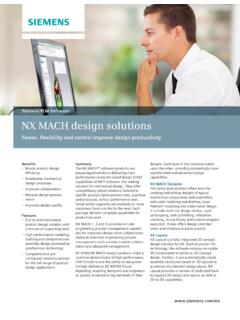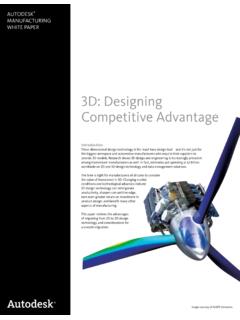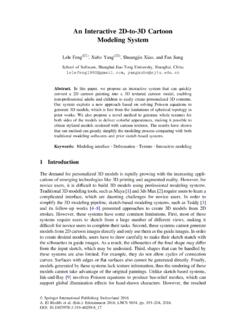Transcription of REINVENTING(2D CAD:( - Siemens PLM Software
1 To date, engineering organizations have compromised between Drafting Tools that cannot drive intelligent change and Feature-based Sketchers whose performance degrades with the hundreds if not thousands of 2D geometry entities on drawings . A third alternative, Direct Sketching, promises to power smart yet fast change for drawings , eliminating such time wasting efforts. REINVENTING(2D ( CAD:( EMPOWERING(TROUBLE5 FREE(2D(DRAWING(CHANGE(Published*by:*(RE INVENTING(2D( CAD:( EMPOWERING(TROUBLE5 FREE(2D(DRAWING(CHANGE( 2(page(Product(development(runs(on(drawi ngs(made(from(2D(geometry. There is no argument: today s preferred means of designing products is 3d modeling . Feature-based modeling captures design intent so 3D models can react to change in smart ways. Direct modeling provides quick and easy ways to push and pull geometry of 3D models.)))))))))))))))))))))))))))
2 However, it is hard to argue that product development doesn't run on engineering drawings composed of 2D geometry. Even when a 3D model is available, the deliverable more frequently used by many downstream departments is based on 2D geometry. Manufacturing leverages drawings to develop production plans. Purchasing utilize drawings in technical packages. Quality, technical publications and marketing transform parts of drawings into many derived publications. That s quite a lot. But that s not the only application of drawings in companies. Think about all of the drawings made up of 2D geometry that were generated before engineering organizations started building 3D models. Most manufacturers literally have thousands of such drawings that were developed over the course of many years.
3 For the products that are still sold and serviced, that is sometimes the only documentation that exists. Those drawings must be put into circulation within the company for any change processes or refits. What s the point in all this? It is simple. If drawings based on 2D geometry are still so prevalent, why are our tools still so poor at manipulating them? Think about the tools that organizations have on hand to modify drawings composed of 2D geometry. There are Drafting Tools that trim, cut, merge and extend 2D geometric entities one by one, offering no intelligent change, that was developed back in the '80s. Then there are Feature-based Sketchers that offer intelligent change, but are easily overwhelmed by large numbers of 2D geometric entities, that was developed back in the '90s when parametric feature-based modeling first emerged.
4 In short, organizations must compromise between outdated tools from completely different eras. Next, consider what s has occurred in the CAD industry over the past few years. There are new innovations surfacing left and right. Yet why has no progress been made on the front of modifying drawings constructed from 2D geometry? The good news is that this story is still being written. Direct Sketching, an alternative for working on drawings built on 2D geometry, has arrived. It powers fast and intelligent change to these deliverables in ways Drafting Tools and Feature-based Sketchers cannot. That's where this eBook comes in. It provides research findings on just how widely drawings based on 2D geometry are still being used. It dissects how and why Drafting Tools and Feature-based Sketchers fall short.
5 It delves into Direct Sketching, which offers new approaches to creating and editing drawings made with 2D geometry. Don't lose hope just yet. Don't just assume wasting inordinate amounts of time working on 2D geometry is just a cost of doing business. Because the story is still being written. ( REINVENTING(2D ( CAD:( EMPOWERING(TROUBLE5 FREE(2D(DRAWING(CHANGE( 3(page(79%$62%$60%$58%$43%$STEP$DXF$2D$P DF$IGES$DWG$Most(Frequently(Used(Formats (for(External(Data(Exchange(Finding from the 3D Collaboration and Interoperability Study, published May 2013, 848 respondents 53%$47%$52%$74%$84%$73%$Service$assess$m aintenance$feasibility$Procurement$build s$supplier$bid$packages$Manufacturing$au thors$instrucLons$3D$Models$2D$ drawings $ 43%$58%$57%$78%$73%$81%$Quality$authors$ documentaLon$MarkeLng$authors$product$sp ecs$Technical$publicaLons$author$deliver ables$Frequency(of(use(of(2D( drawings (an d(3D(Models(outside(Engineering(Are(2D(D rawings(Really(Still(Prevalent?))))))))) ))))))))))))))))))))))))))
6 (Given all the talk about 3d modeling today, it is a fair question to ponder. Findings from the 3D Collaboration and Interoperability study, shown in the figure on the right, provide some factual insights. 2D Formats Rank as the 2nd and 3rd Most Frequently Used External Exchange Medium: For some, the motivation is the protection of intellectual property. For others, the cause lies in the inability of suppliers to accept designs in 3D formats. The reality is that 2D formats are a widely used exchange format with external parties. 2D drawings are Used More Frequently than 3D Models for Several Non-Engineering Purposes: Those cases occur across many departments, including service, procurement, sales, quality, training and technical publications. Here, the reality is that 2D drawings are widely used by many non-engineering organizations.)
7 What s the point here? Well, the point isn t that drawings based on 2D geometry are better than 3d modeling . There are scenarios, like concept design, where the use of 2D tools is legitimate. However, the generation of 2D drawings from 3d modeling is fast route to documenting a design. The point is that 2D drawings are still used in a number of circumstances for manufacturers, not in just a few exceptions that can be ignored. Each of these scenarios needs to support design change. So, the most appropriate next question is simple. What technologies best support 2D drawing change? ( REINVENTING(2D ( CAD:( EMPOWERING(TROUBLE5 FREE(2D(DRAWING(CHANGE( 4(page(Generating( drawings (from(3D(Model s((The reality today is that most engineering organizations create their drawings by laying down views of 3D models.)))))))))))))))))
8 Furthermore, as changes to a design are made, the 3D model is modified, which then propagates to the views on the drawing through associativity capabilities. Practically every modern CAD Software application provides this kind of functionality. Given that, why are we talking about modifying drawings with tools that manipulate 2D geometry? There are two good reasons for doing so. Breaking(Associativity(During(External(E xchanges(In most exchanges of design data with external organization, associativity between 3D models and drawings derived from them are broken. As shown by findings from the 3D Collaboration and Interoperability study, neutral formats that utilize 2D geometry are two of the top three most frequently used exchange mediums with external parties. Exporting drawings from CAD Software application transforms those views of 3D models into 2D geometry that is no longer associative.)))))
9 Those drawings are then often used as the collaboration medium, with markups and comments. Furthermore, it can also be used as a legal specification for delivery. Breaking(Associativity(During(Long(Term( Archival(In addition to the practice of exchanging drawings with 2D geometry that are no longer associative to 3D models, many engineering organizations must develop a strategy to archive documentation for their products for the long term. As CAD Software applications offer improved capabilities release after release, they can sometimes break the ability to open drawings and 3D models built in prior releases. Engineering organizations could open up every drawing and 3D model made in the history of their company and fix every issue that occurs, but it is a significant effort that few can afford in today s tight schedules.))))))
10 Instead, many export such drawings and 3D models into neutral formats. This strips the features away from 3D models and breaks the associativity that drives change to related drawings . But, it does practically guarantee that those deliverables can be opened and used in the future. Brief(Conclusion(In these two cases, the associativity between 3D models and drawings are broken. Therefore, the only means of making changes to the drawings is to modify the 2D geometry. That s the reality in today s product development environment, even with the widespread adoption of 3D model to drawing associativity. As a result, tools to manipulate the 2D geometry in drawings are still needed. ( REINVENTING(2D ( CAD:( EMPOWERING(TROUBLE5 FREE(2D(DRAWING(CHANGE( 5(page(Modifying( drawings (with(Drafting( Tools(When designers and engineers have to manually change drawings with 2D geometry, they often revert back to Drafting Tools that were used for the job for years before 3d modeling became widespread.))))))))))))))))))



















